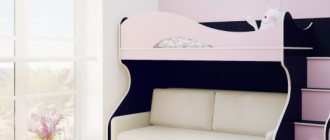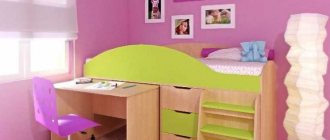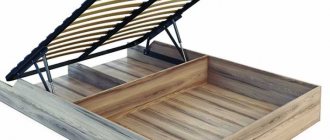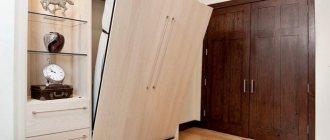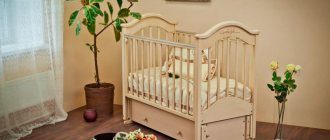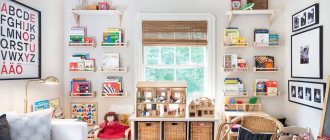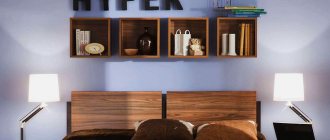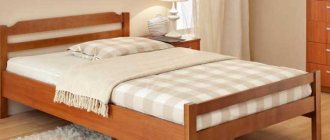Basic criteria for choosing children's beds
Convenience and safety are the most important parameters by which any children's furniture is selected. The crib is selected in accordance with the height and age of the baby, which allows you not to clutter the room with a product “for growth”, replacing it as needed. Baby sleeping furniture is equipped with a protective grille that prevents accidental falls to the floor.
When a child grows up (he is already 5, 7 or 10 years old), his attention is attracted by non-standard designs of cribs in the form of a car, an airplane, a boat, like a princess from a cartoon. In this case, the choice depends not only on the gender of the children, but also on the compliance of the purchased furniture with current standards.
Security - what to consider
A safe product is one that cannot cause injury when interacting with it. The bed should not have gaps between the parts - a curious baby can stick a finger in there and painfully pinch it. Any roughness is also unacceptable - splinters are a very unpleasant thing for thin children's skin. All metal fasteners are masked with wooden or plastic plugs.
The distance between the rods of a baby crib is made no more than six cm. The sides are made removable and stationary. The bed should be quite stable - the narrower and higher the model, the more likely it is to tip over. Any sharp corners or various traumatic decorations are prohibited.
Material of manufacture
It is better to choose natural material from which the bed is made. The most popular are wooden products that are not treated with paint, varnish, or carefully sanded. This is especially important for young children - when the baby is teething, he chews everything, including the sides and bars of the bed. When purchasing, you need to request a hygiene certificate - the design should not have an unpleasant odor or any chemical impurities. When the crib is covered with paint, its composition must be fully described in the certificate - lead and other similar substances are unacceptable.
Models made from mixed materials - wood with MDF, fiberboard, chipboard are also often used, but you should clarify what class of materials are used. Wood in combination with metal and plastic are allowed, but they must be of very high quality. Such designs are painted in bright colors and have an unusual shape.
How tall should a child's bed be?
When a baby is just born, he just sleeps in his crib for most of the day, and spends the rest of the time in his mother’s arms. Here, the height of the sleeping area of the children's bed is set so that it is convenient for parents to bend over to the baby, lift him or check the temperature. Since models for newborns have a high side (up to 110 cm), it is often inconvenient to bend over it and the position of the mattress should be 60-70 cm from the floor. Then the fence is about 30-40 cm, which is enough to prevent a lying baby from falling.
When the child grows up a little and begins to climb, this protective barrier can no longer contain him and changes in the design are necessary. Most models of children's beds are designed to move the base to a deeper position. It is lowered to a level of 30-40 cm from the floor, which automatically increases the height of the vertical side to 60-70 cm. This will protect the inquisitive child from injury for a long time.
For teenagers, the standard height of a children's bed from the floor is the same as for adult models and is selected individually, depending on the child's build. Here it is better to play it safe and buy furniture to grow into.
The optimal value is the height of the sleeping place, sitting on which the bent legs form 90 degrees. This is convenient for getting up quickly, without overloading the muscles of the back, hips and abs. But as the child grows, the bed purchased last year may already be low, so a teenager can choose a height of 30-40 cm, which should be enough until adulthood.
Terms and rules for replacing a bed for a child
Replacing an infant cradle with a larger bed is necessary when it is about to become too crowded for a young family member. After three or four years, the baby reaches a height of 100-108 cm; it becomes a little cramped for him in the standard design with lattice sides, although the possibility of accidentally falling on the floor while sleeping still exists. By this time, a product for preschool age is purchased - low limit bars are still present here, but the baby can climb in and out of the crib on his own.
Often a little man, barely out of toddler age, is forced to give up the cradle to a younger brother or sister who will soon be born. You should accustom your child to a complete “movement” to a big bed in advance - choose similar bedding, try to put stuffed hares, dolls, etc. in it. At first, place pillows and mattresses around the new sleeping place in case of an accidental fall.
Approximate time frame for replacing a child's bed:
- after 6-8 months;
- after 2-3 years;
- after 6-7 years;
- after 12-13 years.
The exact time to change the crib to a new one depends on the height and weight of the little person. If the structure is broken or deformed, it must be replaced immediately.
Types of bunk beds
Do not think that compact bunk beds are produced exclusively
for children and only to save space. All over the world, in armies or in youth chalet/hostel hotels, it is customary to place guests in such interesting rooms. Firstly, such beds are at least non-trivial, and secondly, they are very entertaining for young people.
Therefore, bunk beds can be classified into different types:
- number of zones (playing, educational, sleeping, physical education);
- number of beds;
- age;
- material.
First of all, such beds are popular among children. Even if there is only one child in the family, a bunk bed can contain one sleeping place. The second zone, which is located on the first floor, is a working or physical training zone. And this is very interesting, because at this age a child perceives everything as a game. Agree, it’s much more fun to go down from the second floor using a rope ladder like
Indiana Jones to do your homework than just sit down at your desk.
If there are two or more children in a family, then bunk beds help them become friends, they will spend time together more often when they sleep, study or play.
Most companies produce teenage-type beds to save money. It is larger in size than a standard bed for children, and can be combined to suit height. Some models provide for turning a baby's cradle into a work desk, and the sofa area into a bed. Ergonomics allows you to combine zones in a convenient way without taking up much space, especially if the bed contains a built-in wardrobe or secret drawers.
Therefore, if you are aiming to make a bed yourself, then consider different options, which will differ in complexity and cost.
Standard sizes, models according to the child’s age
An infant crib with lattice sides can, if desired, be used up to almost 6 years old - you just have to remove one of its walls. The optimal dimensions of a sleeping place for children of any age are calculated as follows: add 35-50 cm to the baby’s height so that there is enough free space below and above; the width also does not need to be excessively limited, because many children like to sleep with their arms outstretched.
Products from local and foreign manufacturers are presented on the domestic market. Imported ones usually have slightly larger dimensions - the difference is about 5 cm.
From 0 to 3 years
In accordance with current standards, a child from birth to three years old is purchased a crib with sleeping space dimensions of 110-120 cm by 60 cm. The sides are made no higher than 85-95 cm. The lower position of the mattress is about 30 cm from the floor level, the upper position is 50 cm. The bottom of the product is adjustable in terms of installation height: the upper level is suitable for children under 1.5 years of age, the lower level is acceptable for three-year-olds.
Sometimes cradles are purchased for babies, with the dimensions of the bed itself being 40 by 80 cm - they are completely upholstered in soft material; there are floor-standing models and those suspended from the ceiling. The upper part of the cradle is decorated with a textile canopy, the lower part with a valance. The cradle serves as a kind of cocoon in which the baby is comfortable, because he is protected from all sides; it is used up to a maximum of six months of age.
A rocking bed is intended for children who fall asleep only if they are rocked to sleep - usually this design is a bed with runners on which the entire object moves from side to side. There are also options in which the pendulum is programmed - the time and swing amplitude are set using the remote control.
Side beds
An additional cot is an excellent option for infants. It has small dimensions - approximately 100 by 50 cm, one removable wall, and adjustable bottom height. The design is fastened to the parents' bed and is firmly fixed. This model is equipped with wheels for easy movement around the apartment, and is rectangular and rounded.
Playpen bed
For a very small person, a bed often serves as a playpen, in which it is convenient not only to sleep, but also to play while the mother is busy with household chores. The sides of this multifunctional model are covered with mesh and translucent fabric; the product is easy to assemble and disassemble, which allows you to take it with you on a trip. The minimum dimensions are 90 by 110 cm, height - from 65 cm. The structure is sometimes decorated with a side opening with a zipper.
Transformable bed
Transformable models have a removable side, runners that can be easily removed when they are no longer needed, and are equipped with drawers at the bottom for storing bedding and toys. A practical transformer for older children, it turns from a crib into a sofa, its approximate dimensions are 1400x600 mm or 1700x700 mm. A chest of drawers for storing linen items and a changing table are often attached here. When the baby has grown up, the table with chest of drawers is dismantled, the structure itself is successfully used almost until the end of high school. The only disadvantage of the transformer is its relatively large dimensions.
Sizes for preschoolers, schoolchildren
A crib for a child 4-7 years old has the following dimensions: sleeping area 60 by 140 cm, height from the floor - about 30 cm. After three or four years, enclosing sides are no longer needed. The student’s bed is slightly larger: 80 by 160 cm, its height is 40 cm from the floor level. There are also other parameters - 75 by 150 cm. Many similar products are painted in bright colors, stylized as boats, cars, decorated with lace valances, canopies of delicate colors, and equipped with a drawer that can serve not only as a storage place, but also as an additional surface for board games .
Children of any age love to jump on the bed, so to prevent the furniture from breaking down too quickly, it is recommended to purchase a structure with the strongest possible base.
For teenagers
A teenager needs an almost “adult” bed, with sleeping space dimensions of 70-90 cm by 180-190 cm, up to 50 cm in height. Imported designs are wider - about 100 cm. There are also sliding options that change as they grow older - from 120 to 180 cm. The model is convenient because it does not have to be replaced in a couple of years - the crib is made as durable as possible, from high-quality materials.
A mattress for a “growing” bed does not always need to be completely replaced - individual options are built up using one or two fragments of the same texture as the main item.
Bunk
A bunk bed is purchased when there is not enough space in the apartment, and you have to place sleeping places for two or three children in one room. This item is suitable for ages over three years, up to adolescence. A loft bed is a type of bunk bed; various models are designed for one or two children, equipped with a wardrobe, chest of drawers, sports corner, and desk.
The top bunk of a two-tier structure for younger children should have low guards to prevent falls. The same goes for the stairs leading up.
Non-standard sizes, models
Unusual sleeping products include cots for twins, their standard sizes are 1.3 by 1.25 meters. By the time the twins are four or five years old, two separate beds or one bunk are purchased. Some models for babies are equipped with a carousel toy, musical lighting, and various attachments for rattles. Some modern teenagers are abnormally tall - they require an adult-sized bed, sometimes exceeding 2.1 m in length.
Unique designs that serve as a sleeping place and as a space for story games are made independently or to order. It could be a princess castle or a pirate ship, a racing car or carriage, a spaceship or a luxurious tent. If desired, ladders, slides, and swings can be installed here.
The bed in the form of a dragon's mouth, a boxing ring, a bowl on a leg, a flower bud, a fantasy animal, etc. looks interesting. The headboard and backrest are decorated with colorful prints depicting heroes of your favorite fairy tales and cartoons. You can decorate the building together with the young “heir” - paint it with flowers, cover it with film, letters, numbers.
Types of cribs and their main characteristics
The furniture industry today presents a wide range of children's beds.
The main types of products include:
- cradles;
- side beds;
- beds with playpen function;
- transformable beds.
Cradles, rocking chairs for babies from 0 to 3 years
Cribs in the form of cradles and rocking chairs are presented in various variations.
Their distinctive characteristics are:
- safety;
- comfort of the child's stay;
- compact overall dimensions;
- the baby's motion sickness when waking up;
- mobility.
The disadvantage of using the products is the short service life of cradles - up to a maximum of 6 months, rocking chairs - up to 3 years. Cots-cradles are made on the basis of pendulum mechanisms.
Based on the principle of operation, the types of products are divided:
- longitudinal pendulum, simulating swinging on the hands;
- transverse pendulum, when the bed oscillates from side to side;
- universal, which combines a longitudinal and transverse mechanism (used as desired).
Rocking beds, which are installed on runners placed on the legs of the product, are designed according to the same principle. There are 2 options for placing runners: longitudinal and transverse.
The rocking chair differs from the cradle in its larger dimensions. Over time, it is possible to install special clamps on the runners that block the process of rocking the product or wheels.
Side beds
The dimensions of the crib are standardized, and they correspond to the dimensions of the attached furniture.
This bed performs 2 functions:
- provides a sleeping place;
- used as a playpen.
The benefits of purchasing a side crib include:
- peaceful family sleep;
- safety;
- no possibility of parents injuring the child during sleep;
- products help mothers with health problems;
- small overall dimensions of the console are suitable for small spaces;
- availability of a wide range of products (including multifunctional ones).
Attachments for adult beds are available in various shapes (rectangular, oval and asymmetrical). Wheels are attached to the legs of the products, and clamps are provided that attach the crib to the parents' bed at the required height. The standard size of an additional cot is 50x90 cm, but 120x60 cm can be found.
Playpen bed
Playpen beds become in demand starting from 6 months. up to 2 years, when it is dangerous to leave a child alone.
The advantages of the product are:
- durability and convenience;
- functionality, since the beds can be transformed into a changing table, cradle, desk, cabinet;
- safety;
- adjustable bottom height;
- mobility.
Playpens vary in shape: round, square, rectangular, oval.
According to the child’s age limit, the following types of playpen beds are produced:
- wooden structures of standard sizes for children from 0 to 5 years;
- wooden rectangular transformers intended for children from 0 to 12 years old;
- a playpen bed covered with fabric material, intended for children from 0 to 3 years;
- folding playpen for travel is used from 0 to 1.5 years.
Transformable bed
Transformable beds are a mixture of 2-4 pieces of furniture in one design. The products allow you to increase the size of the bed up to a 12-year-old child.
The model range has the following characteristics:
- number of accessories included in the package;
- the size of the increase in the sleeping bed;
- number of protective elements;
- type of transformation of the component parts of the product.
The following types of transformable beds are available:
- with chest of drawers;
- with extension of the sleeping bed;
- with a folding changing table;
- with the possibility of converting into a playpen;
- with hanging cradles;
- with a pendulum mechanism;
- add-on transformable crib;
- for twins.
The advantages of using products include a long service life and saving money on the purchase of other types of furniture.
Tips for choosing a mattress
The “correct” mattress is important for maintaining a beautiful figure, maintaining the desired position of the spine during night and daytime sleep, therefore you should choose a medium-hard item, and for children and adolescents with posture problems, a hard orthopedic one. The price depends on the filling, cover material, size, and design of the mattress. The product is made as a single or one-and-a-half bed; it must exactly match the size of the sleeping space in a particular bed - using anything smaller or larger is extremely inconvenient.
Mattresses vary in hardness; there are universal, combined options, which, when the child has grown a little, simply turn over to the other side. Hygiene is very important - the mattress should not harbor harmful microorganisms, mold, etc.
The “stuffing” also varies:
- springless mattress - made of a slab and a latex block, containing sisal and coconut fibers, which makes it possible to create parts of any degree of rigidity that best support the spine;
- with a spring block - a universal design in which the springs are combined together or each located separately in individual non-woven covers. The mattress is complemented by a layer of latex or felt.
For non-standard models, the mattress is made to order; regular beds are in most cases sold complete with it.
Ergonomics of children's furniture and anthropometry
Ergonomics studies the movements of the human body during work and the objects in contact with it.
Scientists have calculated every millimeter of space in which we live and entered this information into regulatory documents. For example, the passage between furniture in an apartment should be at least 90 cm. This distance will ensure convenience and safety of movement. Of course, objects can be placed closer, but then, most likely, a person will touch them when walking.
Anthropometry studies human dimensions: height, weight, leg length. Everything that surrounds us adapts to the received data. For example, the height of the step should be 15 cm. If it is higher or lower, the person will feel discomfort.
Anthropometry and ergonomics find the optimal space for a person.
Choice of textiles, pillows
One of the most important parameters of bedding is the hypoallergenicity of both the covers and the filling. On average, a schoolchild spends 8-10 hours sleeping, and an infant spends most of the day, so bedding textiles are chosen very carefully.
What accessories are needed for a baby cot:
- Pillows, no less than mattresses, influence the formation of correct posture and sufficient relaxation of the neck muscles during sleep. For infants, the pillow is made flat - its height does not exceed 3-5 cm. Children who have problems with the spine require an orthopedic pillow, which prevents the deformation process from developing further. There are special C-shaped pads for children who do not yet know how to crawl - they are placed under the chest so that the child does not accidentally roll over, or the baby is “surrounded” with two such products so that he feels safe;
- blanket - made soft, warm. For kids, square blankets with a zipper are suitable, which can easily be converted into an envelope-bag and are equipped with something like a hood in the corner. Blankets are made mainly from natural materials. The best options are flannelette or with the addition of holofiber. There are also two-layer ones, one of which is used in the summer, the other in the fall, and in the case of a cold winter, both halves are fastened with Velcro, forming the warmest blanket possible;
- bedspread, blanket - selected to match the existing interior style, can hide only bed linen or hang down to the floor. It is usually decorated with images of cats, dogs, cartoons, flowers, zebra or leopard prints. The product often serves as a blanket during short naps;
- bed linen – these are pillowcases, sheets, duvet covers that are in direct contact with the delicate baby skin. Such accessories must be permanently colored, moisture-permeable and vapor-permeable, can be easily washed in a machine without losing color or softness, must not contain harmful chemical components, be “prickly”, cause irritation of the skin, or collect static electricity. Linen is usually made from chintz, calico, ranfors, satin, and bamboo. As a summer option for teenagers, the linen option is suitable; younger ones need the most smooth texture. For very mobile babies, sheets with an elastic band are suitable;
- soft sides - designed for infants, serve as protection against accidental injury when hitting wooden rods, are attached to the main structure with ties, Velcro, decorated with multi-colored pictures, made of foam rubber, calico, calico, flannel. If desired, they can be easily sewn by hand, having previously taken measurements of the crib;
- curtains and valances are an exclusively decorative element, most often sold complete with a cradle. All lace, ruffles, and decorations must be firmly sewn on and washed well.

